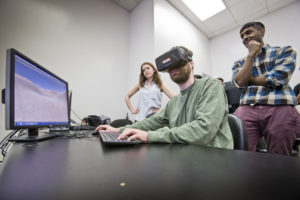Universities are expanding virtual reality course offerings as the technology expands
For 29 students at the University of Maryland, the Spring 2016 semester ended with a virtual walk in the desert and junkyard demolition derby and a digital waterfall created from tweets.
The undergraduate and graduate students were part of the university’s first class in virtual reality, the exploding immersive technology that is expected to generate more than $1 billion in sales this year.
Students spent the semester learning the technical aspects of virtual reality and augmented reality.
They were also tasked with designing virtual demos that they presented as final class projects, offering an array of visually immersive scenarios that included fighting a swarm of zombies, a virtual tour of the UMD campus and a sensor-laden glove that tracked human hand movements.
“It was amazing to see the quality of the demos that came out of the class and lab sessions in a relatively short period of time,” says Galen Stetsyuk, a sophomore majoring in computer science who took the class to build upon his skills as a game developer.
Stetsyuk, president of the student-run UMD VR Club, was part of a team that designed an interactive game called “Junkyard Wars,” where players build a virtual car from scrap parts and then smash it into their opponent’s vehicle.
Another team developed a virtual reality version of “Shade,” the interactive horror fiction game that turns a quiet morning in your apartment into a sand-filled quest to survive in the barren desert.
Alexandria BenDebba, a graduating senior in computer science and member of the Shade team, says she took the class to learn new programming skills.
“Most of the other programming I’ve done involved web-based applications—nothing that involved 3D models. So it was really interesting to code objects that you had to interact with. It took object-oriented programming to a much more literal state,” she says.
One team merged social media with virtual reality. They created a virtual community you could walk through, identifying who lived where by overlaying a person’s Facebook photos on their home’s exterior walls. To relax, you could head to the edge of town and watch a cascading waterfall of your friends’ Twitter messages.
Through a series of case studies and hands-on demos, students were also exposed to potential uses of virtual reality in areas like augmented navigation, medical education and training, and sports training and rehabilitation.
Amitabh Varshney, a professor of computer science co-taught the course, was impressed how students recognized that immersive technologies have applications beyond gaming.
Varshney—who is leading several major research efforts on campus in virtual and augmented reality—recalls a class discussion where the students theorized a virtual game of “Pong” could be used to help people with motion disabilities.
“They are very interested in looking at using virtual and augmented reality in societally important applications,” he says.
“CMSC 498W: Introduction to Virtual and Augmented Reality” was offered through the university’s Department of Computer Science. It covered topics like generating virtual worlds, tracking and registering visual images, and digitally rendering haptics (interactives involving touch) and 3D audio.
Amitabh Varshney, professor of computer science and director of the University of Maryland Institute for Advanced Computer Studies, and Derek Juba, an adjunct lecturer in computer science at UMD and a computer scientist at the National Institute of Standards and Technology, co-taught the class.
- Report forecasts a ‘surge’ in GenAI adoption - April 26, 2024
- Where are microcredentials today–and where are they going? - April 22, 2024
- First-generation students are more likely to seriously consider leaving college - April 17, 2024

